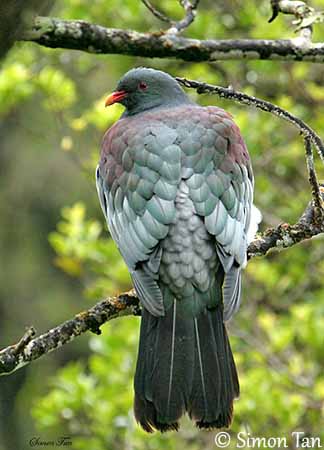
Fr : Carpophage des Chatham
Ang : Chatham Island Pigeon
Maori : Parea
Ita : Piccione delle Chatham
Nd : Chathamduif
Photographers:
John Anderson
John Anderson Photo Galleries
Simon Tan
PBase Bird galleries
Text by Nicole Bouglouan
Sources:
PIGEONS AND DOVES by David Gibbs, Eustace Barnes and John Cox - Pica Press Sussex - ISBN: 1873403607
New Zealand bird status between 2008 and 2012
Wikipedia, the free encyclopaedia
Chatham Island Pigeon
Hemiphaga chathamensis
Columbiformes Order – Columbidae Family
INTRODUCTION:
The Chatham Island Pigeon is still considered a subspecies of the New Zealand Pigeon by some authors, but it is a separate species since 2001, present on Chatham Islands.
This species was formerly common, but predation by introduced species and destruction of the habitat led the population almost to extinction, with only 40 birds by 1990s.
Conservation measures with predator control and protection of several areas by fencing, allowed the increase of the population with about 500-600 individuals by 2009.

RANGE:
The Chatham Island Pigeon is confined to Chatham Islands, and mainly in the southern part. The species was formerly present on Pitt Island too.
HABITAT:
The Chatham Island Pigeon frequents native forest including large tracts and small patches, stunted scrubland and areas covered with ferns, and pastures bordering forests.
CALLS AND SONGS: SOUNDS BY XENO-CANTO
The Chatham Island Pigeon is usually silent, but when alarmed, it gives soft “oos”. The contact call is a low, longer version “oooooos”, rising in pitch towards the end.
BEHAVIOUR IN THE WILD:
The Chatham Island Pigeon feeds on plant matter including leaf buds and flower buds, leaves, flowers and fruits from several plant species. Its preferred fruits come from New Zealand species such as hoho (Pseudopanax chathamicus), matipo, mahoe and karamu trees. It also takes leaves, including those of clover.
The fruits of the hoho are its favourite food, and the Chatham Island Pigeon breeds in August-September when these fruits are at their best.
This pigeon has an enlarged hind toe, well-adapted for feeding on the forest floor, whereas its robust beak allows it to feed on hard hoho’s leaves. It spends considerable time on the ground, grazing and feeding on various plant species.
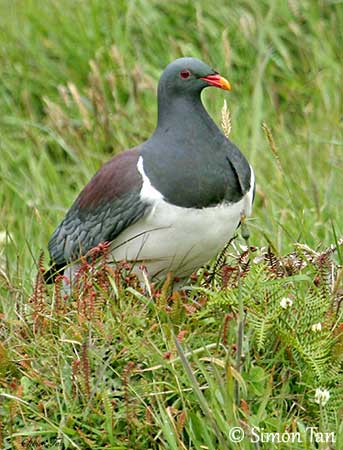
During the breeding season, the male performs spectacular flight displays. The bird flies upwards from a perch, then stalling with spread wings and tail, before to dive sharply down. Then, the male stands erect with puffed out breast feathers. These displays are used to attract a mate.
The territory is defended by the pair during the breeding season. They roost at top of dead trees or on exposed branches, at hilltop or other elevated area.
The Chatham Island Pigeon is sedentary with some local movement related to food resources.
It flies with powerful, noisy wingbeats.
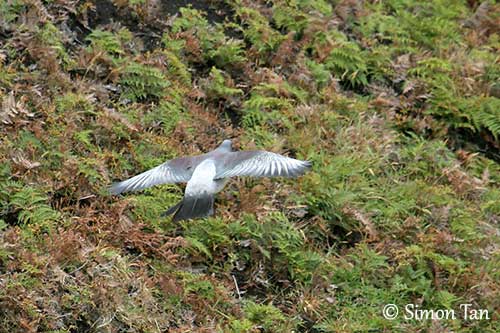
PROTECTION / THREATS / STATUS:
The Chatham Island Pigeon is very vulnerable to predation by introduced species such as feral pigs and cats, but the Weka also takes eggs and chicks.
Pest-control reduces the incidence of predation, allows the regeneration of the forest, and reduces the competition for fruit availability. The fencing of several areas is also a good protection for the native vegetation.
With a rapid increase of the small population, from 40-50 birds by 1990s to 500-600 individuals by 2009s, the Chatham Island Pigeon was classified as Nationally Vulnerable in 2013.
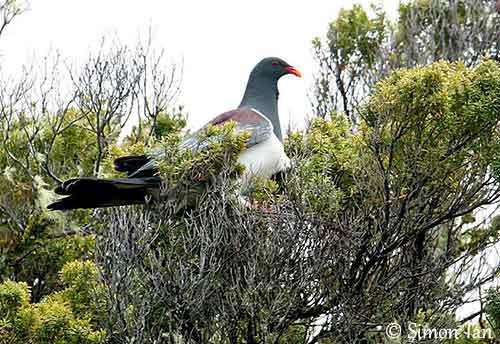
REPRODUCTION OF THIS SPECIES:
The breeding season occurs between June and November, with peak in August-September during the fruiting season of the hoho.
The nest is placed near the ground, often in ferns. This is a platform made with twigs.
The female lays a single egg, much bigger than the egg of the New Zealand Pigeon. Both parents incubate during about one month. The chick is brooded continuously during two weeks. When it is well covered with feathers and until it fledges, both adults leave it alone during the day, with short visits to feed it.
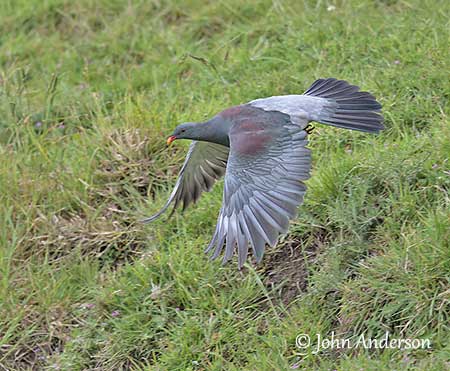
DESCRIPTION OF THE BIRD:
Biometrics:
Length: 55 cm
Weight: up to 800 g
The adult is a large, heavy pigeon, larger and heavier than the New Zealand Pigeon.
Its plumage is duller and greyer. The upperparts and the upper breast are more pearl grey and purple, but rest of underparts is white.
Head, neck and breast are less metallic, the nape has less purple gloss, and the mantle shows reduced purple-brown colour and duller appearance. Outer wing-coverts and outer webs of the primaries are pearl grey to silvery-white. Back and rump are ashy-grey and slightly washed green. The tail is uniformly dark. The undertail-coverts have dark glossy green tips, and the rectrices are more blackish. On the underwing, the flight feathers are paler grey.
The red bill with yellow tip is heavier, with more hooked tip than in New Zealand Pigeon. The eyes are red. Legs and feet are dark red. We can see an enlarged hind toe.
Both sexes are similar and the juvenile is duller overall.
